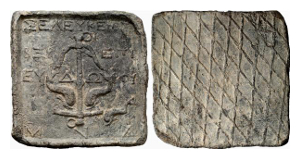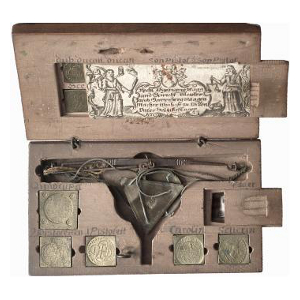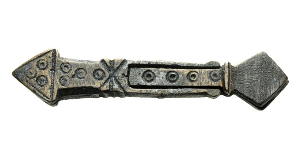Coin Scales and Weights (16th-20th Centuries)
Long before coins had an embossed and guaranteed value (face value), it was above all the precious metal content which was decisive regarding their buying power. Thus the coin scale was for centuries the constant companion of the merchant and the moneychanger. Many denomination-related terms such as shekel (“the weighed”) and dupondius (“two pounds”) are derived from weights.

Seleukidisches Reich. Bleigewicht zu einer Mina, 162-145. Zuschlag: 6.000 Euro.
Specially-produced coin scales were used in all periods for the examination of coins for their full weight and authenticity. In the Middle Ages it was primarily light, collapsible scales which served for the weighing of coins and precious metals (“hack-silver”), as the assortment of minted types was nearly incalculable. Beginning in the 16 century, coin scale sets consisting of scale beams, scale dishes and weights were stored in easily transportable and decorative wooden boxes. The accompanying weights were not indexed to a defined unit of measurement such as grams or ounces, but rather to the corresponding coin denomination: ducat, taler or noble. The selection of the coin type to be weighed with the coin scales was made either through the written indication on the weight (e.g., 1 LsDOR = 1 louis d’or or 1 GOLD GULD = 1 gold gulden) or via the image embossed on the coin. In order to distinguish them from the original currencies, the weights with the coin scales were usually rectangular and made of brass.

Münzwaage 1757 von Jacob Grevenberg, Köln. Zuschlag: 1.300 Euro.
In Germany, most coin scales of the 16th-18th centuries came from Nuremberg or Cologne and were true “export hits” of these cities. Beginning in the 18th century in the Bergisches Land (“mountainous country”) region a further center of German scale production emerged, and whole families of artisans were active in their manufacture in Barmen, Radevormwald, Lennep and Solingen for more than half a century. In the greater European sphere, coin scales were also produced in large numbers in the trade centers of Amsterdam, Paris, Milan and Venice. Small “fast scales” were already in general use during the German Empire period for the inspection of 5-, 10- and 20-gold-mark pieces (patented gold coin scales), including those by well-known companies such as “A. Schimmel” of Leipzig and “Alex Bernstein & Co.” of Berlin. From the end of the 19th century, however, the gold coin – and thus also the coin scale – lost their significance in payment transactions.
The finely-detailed scales and their ornately-embellished wooden cases bearing information on the manufacturer are today collectors’ objects, just as desirable as the coins for whose inspection they were originally manufactured. In addition to the coin scales, related measurement instruments such as precious metal- (with grain weights), apothecary- (with weights of grain, drachm and scruples) and diamond scales (with weights in carats), or individual weight sets can be included in the collection.

Osmanische Kippwaage für Goldmünzen im Gewicht von ca. 2,4 g. Zuschlag: 7.500 Euro.
Experience the fascinating world of scales and weights from a time which, as yet, had no unified measurement-, coin- and weight system.
Introductory literature:
- Bastian, R.: Die Münzwaage in der Hand des Sammlers, Schalksmühle 1983.
- Eiselmayr, G.: Münzgewichte und Münzwaagen aus Österreich, Linz 2008.
- Schnieder, J.: Europäische Waagen- und Gewichtemacher und ihre Marken, Rechtsupweg 2003.
- Stumpf, G. / Kruse, F. W.: Auf die Goldwaage gelegt (Staatliche Münzsammlung München), München 1998.
- Unshelm, G.: Die bergischen und märkischen Goldwaagen 1749-1850, Paderborn 2011.

